
Burning all the oil and gas from new discoveries and newly approved projects since 2021 would emit at least 14.1bn tonnes of carbon dioxide (GtCO2), according to Carbon Brief analysis of Global Energy Monitor (GEM) data.
This would be equivalent to more than an entire year’s worth of China’s emissions.
It includes 8GtCO2 from new oil and gas reserves discovered in 2022-23 and another 6GtCO2 from projects that were approved for development over the same period.
These have all gone ahead since the International Energy Agency (IEA) concluded, in 2021, that “no new oil and gas fields” would be required if the world were to limit global warming to 1.5C .
Since then, world leaders gathering at the COP28 summit at the end of 2023 have also agreed to “transition away from fossil fuels”.
Despite this, nations such as Guyana and Namibia are emerging as entirely new hotspots for oil and gas development. At the same time, major historic fossil-fuel producers, such as the US and Iran, are still going ahead with large new projects.
Additionally, oil majors such as TotalEnergies and Shell that have made public commitments to climate action, are among the biggest players investing in new oil and gas extraction around the world.
In 2021, the IEA issued its first “net-zero roadmap”, setting out a pathway for the world to limit warming to 1.5C. The influential agency concluded that:
“Beyond projects already committed as of 2021, there are no new oil-and-gas fields approved for development in our pathway.”
This statement has become a rallying cry for campaigners and leaders pushing for a phase out of fossil fuels.
The IEA has since clarified that there would be no need for new oil and gas developments if the world gets on track for 1.5C. It has also slightly softened its language, by allowing for new oil and gas projects with a “short-lead time” within its 1.5C scenario.
Yet it has also warned of the risk of “overinvestment” in new developments, noting that current spending is “almost double” what would be needed under its 1.5C pathway.
In any case, the IEA’s message has been widely ignored by oil and gas companies, which have continued to search for new extraction opportunities.
In its new global oil and gas extraction tracker, GEM identifies 50 new sites discovered in 2022 and 2023, after the IEA issued its initial net-zero roadmap. The oil and gas reserves from these projects amount to 20.3m barrels of oil equivalent (Mboe).
The tracker also identified a further 45 projects that have reached “final investment decision” (FID) since the IEA’s roadmap, with an extra 16Mboe of reserves. FID is the point at which companies decide to move ahead with a project’s construction and development.
If all the oil and gas in the newly discovered reserves is burned in the coming years, an extra 8GtCO2 would be released into the atmosphere, according to Carbon Brief analysis. Adding the reserves discovered between 2022-23 brings this total to 14.1GtCO2.
This is equivalent to more than one-third of the CO2 emissions from global energy use in 2022, or all the emissions from burning oil that year, as shown in the chart below.

These findings are in line with mounting evidence that both company and government plans for fossil fuels are not aligned with their own climate goals.
According to the most recent UN Environment Programme “production gap” report, companies are planning for gas and oil production that is 82% and 29% higher, respectively, than would be needed in a 1.5C pathway.
The remaining “carbon budget” of emissions that can be released while retaining a 50% chance of limiting warming to 1.5C is just 275GtCO2, according to the Global Carbon Budget consortium of scientists. Burning all of the contents of the new oil and gas schemes identified by GEM would use up 5% of this remaining budget.
Moreover, the GEM report points out that new projects take, on average, 11 years to start producing significant amounts of oil and gas. This means that most will not enter production until the 2030s.
By this point, according to the IEA, fossil-fuel demand would have fallen by “more than 25%” if the world gets on to a 1.5C-compliant pathway.
GEM also notes that its analysis likely underestimates the scale of new fossil fuel developments. It excludes smaller sites and those where the size has not been publicly announced, such as new gas fields discovered in Saudi Arabia in 2022.
The IEA updated its net-zero scenario in 2023 to reflect the continued expansion of fossil-fuel projects since its previous report. It stated that:
“No new long lead time conventional oil and gas projects need to be approved for development.”
It added that falling demand for fossil fuels “may also mean that a number of high cost projects come to an end before they reach the end of their technical lifetimes”, again if the world gets onto a 1.5C pathway.
To reflect the IEA’s new language around avoiding “long lead time” and “conventional” projects, GEM excludes expansions of existing projects and “unconventional” sites from its analysis. The report notes that including them would roughly quadruple the size of the reserves that reached a FID in 2022-23.
Many oil companies have made it clear that they do not intend to wind down their fossil-fuel operations in the near future.
This is true even for those that have made commitments to climate action, such as Shell and TotalEnergies. (Some oil majors have also watered down their pledges in recent months.)
As the chart below shows, many of the companies with the largest share of new oil and gas schemes have also announced net-zero targets.
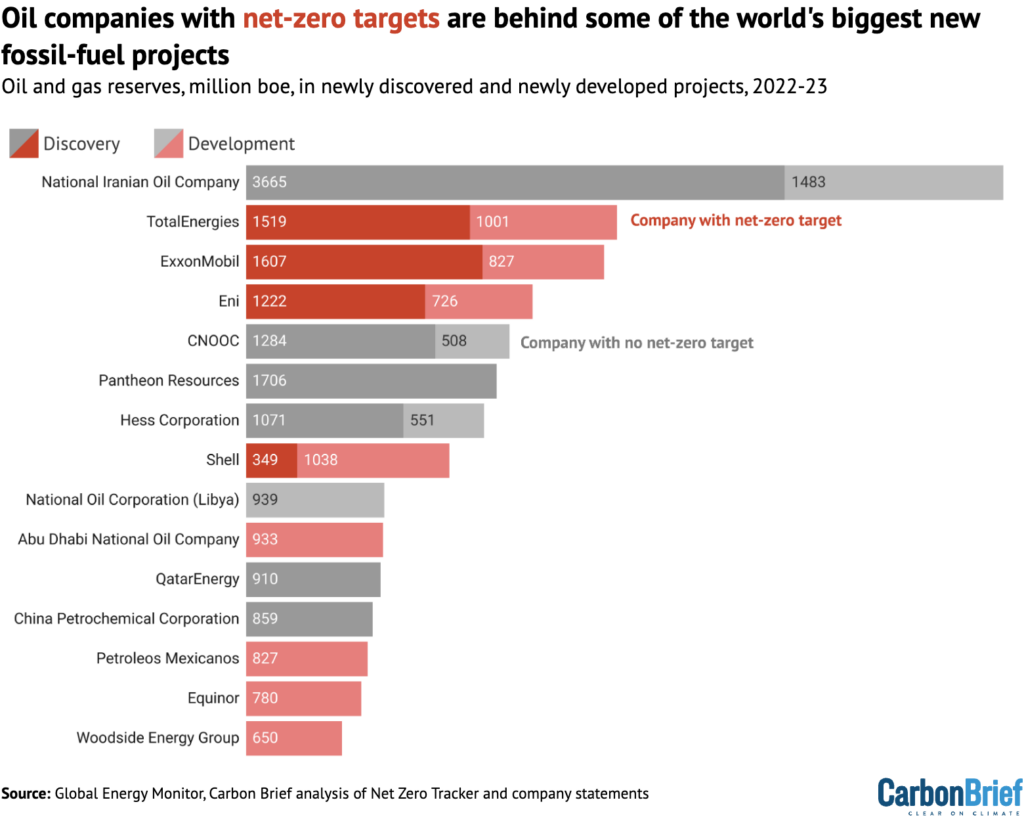
The top rankings are dominated by publicly traded oil majors, such as ExxonMobil, and national companies, such as the Abu Dhabi National Oil Company (ADNOC) – which is led by COP28 president Sultan Al Jaber. Saudi Aramco, the world’s largest oil company, is missing from the GEM tracker, likely due to the lack of data from Saudi Arabia.
The emissions that could result from new gas fields run by the state-owned National Iranian Oil Company alone amount to 1,700MtCO2, according to Carbon Brief analysis. This is higher than the annual carbon footprint of Brazil.
Meanwhile, oil and gas in new projects being developed by TotalEnergies and ExxonMobil could generate roughly 1,000MtCO2 – equivalent to Japan’s annual total – for each company.
At the recent CERAWeek industry conference, many oil and gas industry leaders argued against a transition to cleaner forms of energy. For example, Saudi Aramco chief executive Amin Nasser told attendees: “We should abandon the fantasy of phasing out oil and gas.”
As companies continue searching for more oil and gas, executives have consistently emphasised that demand for fossil fuels, rather than production, is the problem.
Most recently, in an interview with Fortune, ExxonMobil chief executive Darren Woods placed the blame on the public, who he said “aren’t willing to spend the money” on low-carbon alternatives.
New nations, mainly in the global south, are opening up as “global hotspots” for oil and gas projects, according to GEM.
Notably, Guyana is set to have the highest oil production growth through to 2035. Over the past two years, it has already been the site of more new oil and gas discoveries than any other country. Namibia has also opened up as a major new frontier in fossil-fuel extraction.
The chart below shows how nations that have recently been targeted for oil and gas exploration, now make up a large portion of new discoveries and developments.
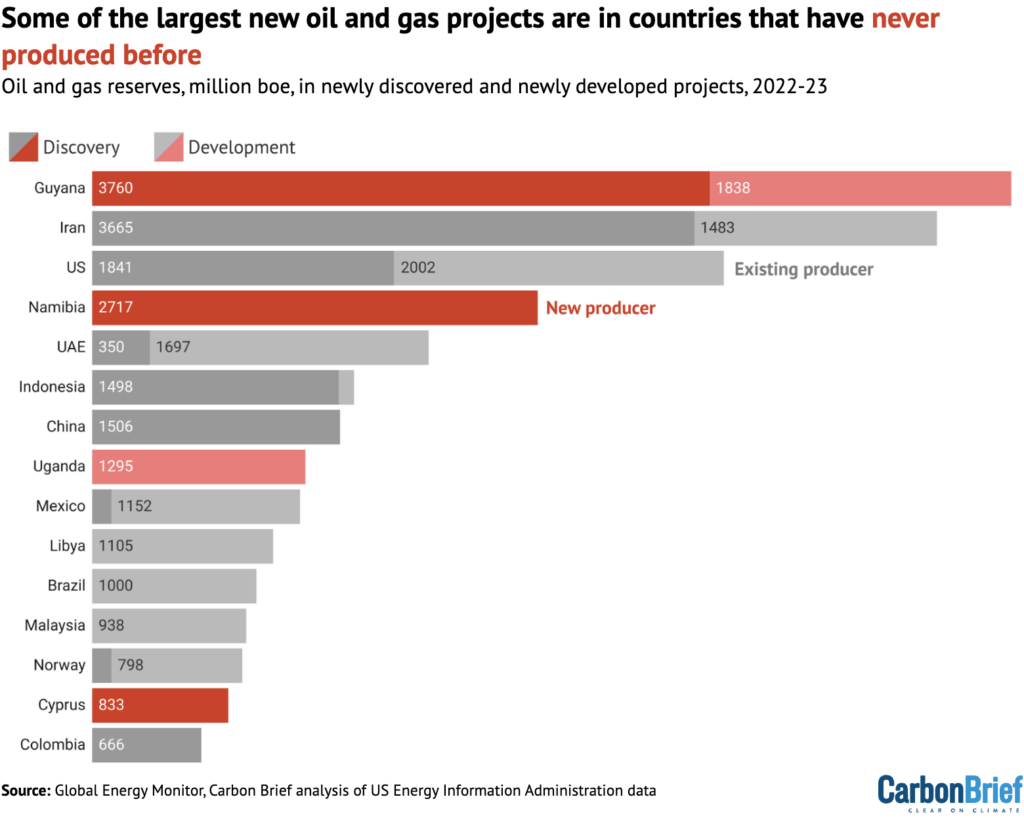
The expansion of oil and gas production in the global south is a highly politicised topic.
Many African leaders, in particular, argue that their countries are entitled to exploit their natural resources in order to bring benefits to their people, as global-north countries have done. At COP28, African Group chair Collins Nzovu stated that oil and gas were “crucial for Africa’s development”.
(It is worth noting that, according to GEM’s analysis, companies based in the global north such as ExxonMobil, Hess Corporation and TotalEnergies own most of the reserves in the new global-south projects.)
Meanwhile, wealthy oil producers such as the US, Norway and the UAE justify their continued fossil-fuel extraction by saying their production emissions are relatively low. Others, such as the UK, argue that they need to exploit domestic reserves to preserve their energy security.
Even in a 1.5C scenario, the IEA still includes a significantly reduced amount of oil and gas use in 2050. Most of it goes towards making petrochemicals and producing hydrogen fuel.
However, in last year’s report on the position of the oil and gas industry in the net-zero transition, the agency also emphasises that this does not mean everyone can continue producing.
“Many producers say they will be the ones to keep producing throughout transitions and beyond. They cannot all be right,” it concludes.

EQUITY: Nearly half of Americans live in states that don’t bar electricity shutoffs during heatwaves, putting 45 million low-income Americans at risk of being unable to cool their homes when heat turns deadly. (The Guardian)
POLITICS:
GRID:
OIL & GAS:
WIND:
SOLAR:
ELECTRIC VEHICLES:
COMMENTARY: Two energy justice researchers warn the U.S. is experiencing an electricity disconnection crisis as utilities are allowed to shut off power to residents who can’t pay their bills even in deadly heat. (The Conversation)

OIL & GAS: Native Alaska communities sue the Biden administration over its oil and gas drilling ban on 10.6 million acres in a national petroleum reserve, saying it violates federal laws. (Bloomberg Law)
CLIMATE:
ELECTRIFICATION: A fossil fuel trade group plans to file a lawsuit seeking to block Denver, Colorado’s building codes restricting natural gas appliances in commercial and multifamily buildings. (CPR)
BATTERIES:
SOLAR:
EFFICIENCY: The U.S. Energy Department awards California and Utah a total of $7.3 million to advance building decarbonization and other efficiency-oriented programs. (news release)
GRID: Federal regulators approve incentives for Southern California Edison’s proposed transmission projects aimed at reducing congestion and increasing access to utility-scale solar. (RTO Insider, subscription)
UTILITIES:
URANIUM:
CLEAN ENERGY: Observers expect an upcoming Hawaii energy strategy to suggest using liquefied natural gas generation as a bridge to help the state reach its 100% renewable energy goal. (Honolulu Civil Beat)
COMMENTARY: After visiting a New Mexico oil and gas drilling site, an author and advocate concludes the “fossil fuel industry chases short-term profit and leaves long-term wreckage in its wake.”(Guardian)

OIL & GAS: After a judge ends the Biden administration’s pause on new liquefied natural gas projects, observers say the 6-month delay may end up being “little more than a speed bump” for the growing industry, as it didn’t affect terminals under construction and only delayed a few projects. (Grist)
ALSO:
STORAGE: A national clean energy group releases a model ordinance for local governments to use for regulating the permitting, siting, safety and decommissioning of energy storage systems. (Utility Dive)
EMISSIONS: Google says its greenhouse gas emissions have jumped 48% over the past five years, in part because of its implementation of AI. (The Guardian)
WIND: Federal officials give their approval for the 2.8 GW Atlantic Shores project, the first offshore wind facility in New Jersey. (Power Technology, NJ Biz)
SOLAR: The U.S. Supreme Court orders a lower court to reconsider a 2023 ruling affirming federal regulators’ approval of a solar-plus-storage facility in Montana after overturning the Chevron deference doctrine. (E&E News)
ELECTRIC VEHICLES:
CARBON CAPTURE: A Western governors group’s decarbonization report calls for pioneering industrial and natural carbon capture and sequestration efforts, but says little about reducing fossil fuel burning or transitioning to clean energy. (Inside Climate News)
PIPELINES: North Dakota Gov. Doug Burgum could play a key role in deciding whether a carbon pipeline can move forward, as his political profile rises and he balances donor influence and landowner opposition. (CNN)
COAL: Unprecedented federal funding from the Bipartisan Infrastructure Law is helping Southwest Virginia diversify its economy through redevelopment of abandoned mine land sites. (Virginia Mercury)
GEOTHERMAL: A Colorado report predicts state investment will spur industry to develop several utility-scale geothermal electricity plants in coming years. (Colorado Sun)

EMISSIONS: Amid ongoing consideration of Duke Energy’s plan to meet North Carolina’s carbon emission goals, the state consumer advocate criticizes the utility for failing to leverage a federal loan program to save ratepayers hundreds of millions and build more clean energy. (Energy News Network)
ALSO:
OVERSIGHT: The U.S. Supreme Court declines to take up a case challenging the statewide election of Georgia’s energy regulators, essentially clearing the way for elections to resume in 2025. (Associated Press)
GRID:
OIL & GAS:
SOLAR: A Virginia county planning board recommends against approving a solar farm on 2,000 acres. (WCYB)
COAL: Alabama residents complain that a mining company and public officials are ignoring their concerns about a growing underground coal mine with a lengthy list of safety violations that culminated in a fatal explosion in March. (Inside Climate News)
WIND:
ELECTRIFICATION: The mayor of Miami-Dade County, Florida, announces Miami will be the first major cruise port on the Eastern Seaboard to implement shore power, which allows cruise ships to cut their engines and plug into landside electrical power. (Miami’s Community News)
OVERSIGHT: Virginia Gov. Glenn Youngkin announces the expansion of a website to give the public more information about pending permits at six agencies, including the state’s energy and environmental regulation departments. (Virginia Mercury)
COMMENTARY:
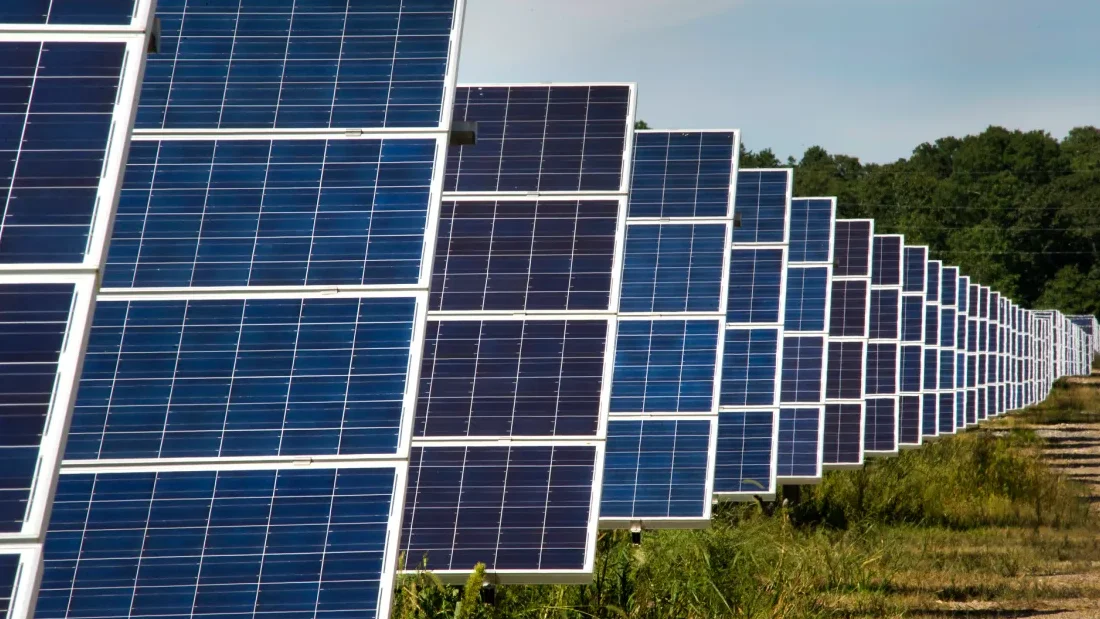
CLEAN ENERGY: Renewable energy developers in Ohio are pessimistic about accessing Inflation Reduction Act tax credits as they attempt to overcome fossil fuel-backed groups’ misinformation and burdensome state regulations. (Floodlight)
ALSO:
SOLAR:
WIND: Two central Wisconsin towns are being sued for overly strict wind energy rules that challengers say are more restrictive than state regulations. (WPR)
ELECTRIC VEHICLES: Michigan school districts report initial technological challenges with electric school buses, though supporters say a pilot program is gathering key usage data. (MLive)
CARBON CAPTURE: The developer of a large carbon capture project at a North Dakota coal plant delays a final decision on construction as costs increase and regulatory concerns grow. (E&E News, subscription)
PIPELINES:
OIL & GAS: Unregulated gas certification programs that aim to help the fossil fuel industry label natural gas as a clean fuel are a “greenwashing scam,” according to a new report from environmental groups. (Inside Climate News)
UTILITIES: A federal administrative law judge rules that a North Dakota electric cooperative should return $471 million to customers for costs that shouldn’t have been included in rates for a non-utility coal gasification plant. (KFGO)
BIOFUELS: Environmental groups want the federal government to require large biofuel plants to install air pollution monitoring devices and tighten the enforcement of air pollution permits. (MLive)
HYDROELECTRIC: A southern Minnesota hydroelectric dam is in “imminent failure condition” as high river levels caused water to breach the side of the facility and wash away a nearby substation. (MPR News)

OIL & GAS: Federal regulators approve the $10 billion Calcasieu Pass 2 liquified natural gas export terminal in Louisiana despite the Biden administration’s pause on permitting such projects; the company says it’s still waiting for approval to export the fuel. (Floodlight)
ALSO: Virginia residents protest potential construction of a 1,000 MW gas-fired power plant, although a Dominion Energy official says it hasn’t yet finalized its decision where to build the project. (WRIC)
CLIMATE: An Alabama grant program to strengthen roofs to lower insurance premiums and stave off a climate-related withdrawal by insurance companies has become a model that’s been replicated by at least five other states. (Stateline)
SOLAR:
NUCLEAR:
HYDROGEN:
EMISSIONS: The U.S. Supreme Court pauses the U.S. EPA’s planned “good neighbor” rule to reduce the amount of smog that crosses state lines, which was challenged by West Virginia, Indiana, Ohio and industry groups. (Texas Tribune)
PIPELINES: A firm files a lawsuit by 35 Oklahoma landowners to force a pipeline company to clean up their properties. (KWTV)
OVERSIGHT:
COAL: An energy company tells Texas regulators it plans to restart a 779 MW coal-fired unit that’s been down since March for maintenance. (Reuters)
GRID:
CLEAN ENERGY: An Oklahoma economic development authority receives $100,000 in federal funding to attract clean energy companies. (KWTV)
COMMENTARY: A West Virginia lawmaker touts the state’s oil and gas industry along with the potential for carbon capture and hydrogen projects. (Charleston Gazette-Mail)

A new analysis says Vermont is not on track to meet its 2025 target for reducing greenhouse gas emissions, with declines in thermal fossil fuel use driven mostly — though not entirely — by warming winters.
The study, released last month by the Vermont nonprofit Energy Action Network, also shows signs of progress: Though rising temperatures are still the main driver of lower heating fuel sales, weatherization and electric heat pump adoption are starting to have a greater impact.
“Vermont’s efforts… are, ironically, being aided by the very global heating that we are working to do our part to help minimize,” the study says. “Relying on warmer winters to reduce emissions from fossil heating fuel use is not a sustainable strategy. … What [the warming trend] means for temperatures — and therefore fuel use — in any given year is still subject to variation and unpredictability.”
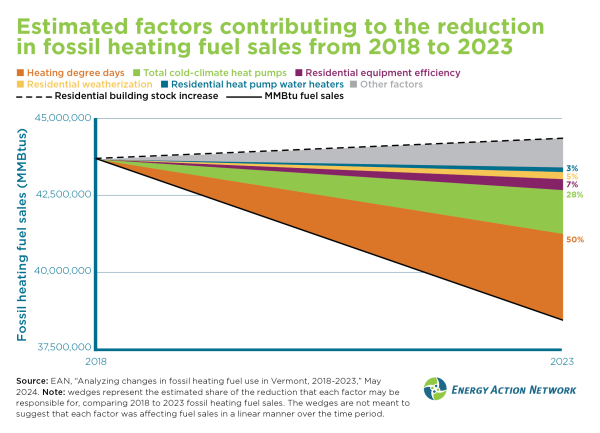
Like most other New England states, Vermont relies heavily on heating oil and, to a lesser degree, propane and utility gas, to heat buildings. This makes the building sector a close second to transportation in terms of the biggest contributors to planet-warming emissions in Vermont and many of its neighbors.
Vermont’s statutory climate targets, adopted in 2020, aim to cut these emissions by 26% below 2005 levels by next year, with higher targets in the coming decades.
“It’s technically possible” that Vermont will meet its thermal emissions goal for next year, but “at this point, primarily dependent on how warm or cold the fall and early winter heating season is at the end of 2024,” EAN executive director Jared Duval said. The transportation sector would need to see a nearly unprecedented one-year decline.
On the whole, EAN says it’s “exceedingly unlikely” that Vermont will meet its 2025 goal.
EAN found that heat pump adoption and weatherization are not happening fast enough, and what’s more, the current trend sets Vermont up for a Pyrrhic victory at best: Rising temperatures in the upcoming heating season would have to be at least as pronounced as in last year’s record-warm winter in order to reduce fuel use enough to meet the 2025 target for the thermal sector.
Either way, warming alone won’t get Vermont to its 2030 target of a 40% drop in emissions over 1990 levels, Duval said. The state wants to end up at an 80% reduction by 2050.
“The only durable way to reduce emissions in line with our science-based commitments is to increase the scale and pace of non-fossil fuel heating solutions and transportation solutions,” he said.
The EAN study found that fuel sales tend to decline alongside heating degree days: a measurement of days when it’s cold enough to kick on the heat. Vermont is seeing fewer of these days overall as temperatures warm.
“The reduction in fossil heating fuel sales as winters have been warming is not surprising,” Duval said. “Historically, fossil heating fuel use and therefore greenhouse gas emissions have largely tracked with heating demand, with warmer winters corresponding with less fossil fuel use and colder winters with more fossil fuel use. The good news is that’s not the whole story.”
In recent years, he said, fuel sales have begun to “decouple” from the warming trend to which they were once more closely linked. From 2018 to 2023, EAN found that Vermont fuel sales declined 12% while heating degree days only declined 8%.
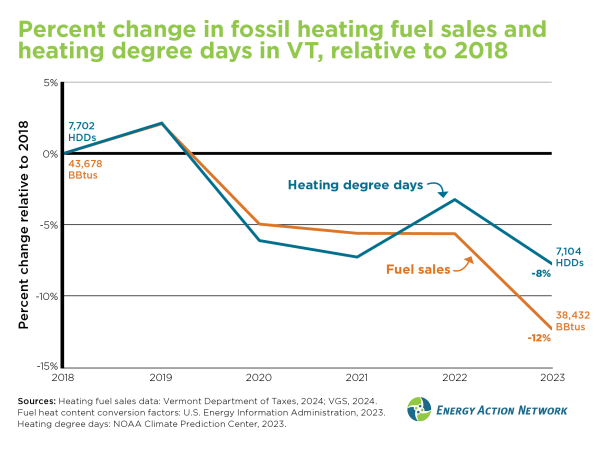
“Fossil heating fuel sales are declining even more than you would expect just from warmer winters alone,” Duval said. “And that’s because many non-fossil fuel heating solutions are being adopted.”
From 2018 to 2022, EAN found, Vermont saw a 34% increase in weatherization projects and more than 50,000 more cold-climate heat pumps installed in homes and businesses, with a 3.3% increase in the number of homes that said they use electricity as their primary heating fuel.
The upshot: The number of cold days explains 50% of Vermont’s declining fuel use from 2018 to 2023, while heat pump growth explains as much as 28% and other efficient upgrades explain a further 15%. The remaining 7% of the decline couldn’t easily be broken down and could partly be from people shifting to wood heat during periods of high fuel prices, Duval said.
“In order to achieve thermal sector emissions reduction targets without relying primarily on an abnormal amount of winter warming, significantly more displacement and/or replacement of fossil heating fuel… will be necessary,” the study says. Upgrades like heat pumps will lead to more sustainable emissions cuts, it says, “no matter what the weather-dependent heating needs in Vermont will be going forward.”
EAN is nonpartisan and doesn’t take policy positions, but research analyst Lena Stier said this data suggests that expanding Vermont’s energy workforce and tackling heat pumps and weatherization in tandem would spur faster progress on emissions cuts, while keeping costs low.
EAN based its estimates of fuel use and emissions impacts from heat pumps on the official assumptions of a state-approved technical manual, which Duval said may be overly optimistic. But Stier said the reality could differ.
“We’ve heard anecdotally that a lot of people who have installed heat pumps in their homes… are kind of primarily using them for cooling in the summer,” she said. “So our kind of assumption is that, in reality, it would be a smaller share of that (fossil fuel use) reduction coming from heat pumps.”
While fuel use declined overall in the study period, he said this came mostly from people using less heating oil specifically — propane sales actually increased in the same period.
Duval noted that propane is cheaper than oil on paper, but actually costs more to use because it generates heat less efficiently than oil does.
“Once you look at that, then heat pumps become that much more attractive,” he said.
Editor’s note: This story has been updated for clarity.

COAL: Stalled efforts to redevelop a former coal plant property in Indiana reflect a broader struggle for local officials who face legal obstacles when seeking to repurpose contaminated power plant sites. (Inside Climate News)
ALSO: An Iowa Environmental Council study says pollution from two MidAmerican coal plants over a 20-year period caused 165 premature deaths and higher rates of asthma, COPD and heart disease. (Radio Iowa)
PIPELINES: After Iowa legislation to limit the use of eminent domain for carbon capture pipelines fails for a third straight year, lawmakers and activists vow to try again next year. (Cedar Rapids Gazette)
ELECTRIC VEHICLES: General Motors will stop producing the Chevrolet Malibu and invest $390 million in a Kansas assembly plant to make more electric vehicles. (Reuters)
FOSSIL FUELS: Ohio House lawmakers pass a bill allowing a facility that burns coal to produce coke used in the steelmaking process to claim renewable energy credits. (Cleveland.com, subscription)
CLEAN TECH: Researchers at a national laboratory in Iowa are researching ways to convert non-recyclable plastic into fuels, oils and other materials. (Iowa Capital Dispatch)
GRID:
SOLAR:
CLIMATE: Michigan becomes the latest state to propose a constitutional amendment to enshrine clean water, air, soil and a stable climate as a fundamental right, which in some states has led to limits on oil and gas drilling. (Planet Detroit)
EFFICIENCY:
COMMENTARY: An Ohio farmer says the East Palestine train derailment that damaged his property also opened his eyes to the benefits of clean energy and a proposed community solar bill. (Columbus Dispatch)

CLIMATE: California Gov. Gavin Newsom unveils a climate plan that would see the state leverage more than 50 million acres of its land to optimize carbon absorption and reduce wildfire risk. (Los Angeles Times)
ALSO: A Wyoming city and tribal nation seek federal greenhouse gas emissions-reduction funds for solar projects, microgrids and electric vehicles after the state refused to apply for the grants. (Inside Climate News)
UTILITIES: California lawmakers kill legislation that would have tightened regulations prohibiting utilities from spending ratepayer funds on advertising or lobbying. (Associated Press)
SOLAR:
WIND: The federal Bureau of Land Management extends the public scoping period for the proposed 600 MW Jackalope wind facility in Wyoming. (Cheyenne Post)
EFFICIENCY: Honolulu officials plan to extend efficiency measures to 80 additional facilities after they saved the city $2.7 million in utility costs last year. (KHON)
CLEAN ENERGY: Utah cities scramble to find clean energy sources after Rocky Mountain Power decided to postpone its planned coal-generation phaseout. (Salt Lake Tribune)
TRANSPORTATION:
WIND: The federal Bureau of Land Management extends the public scoping period for the proposed 600 MW Jackalope wind facility in Wyoming. (Cheyenne Post)
BATTERIES: Colorado’s economic development commission approves $1.1 million in incentives for a proposed sodium-ion battery manufacturing facility in the northeastern part of the state. (Greeley Tribune)
LITHIUM: California advocates file a lawsuit challenging a proposed direct lithium extraction operation at the Salton Sea, saying the county’s review downplays the project’s water use and other environmental impacts. (inewsource)
COAL: Federal regulators indicate they will nullify a new Montana law loosening water quality standards for coal mines because it is weaker than federal rules. (Montana Free Press)
OIL & GAS: The federal Bureau of Land Management seeks public input on a proposal to revoke oil and gas leases on 6,000 acres in the Permian Basin that are the target of an environmentalists’ lawsuit. (KRQE)